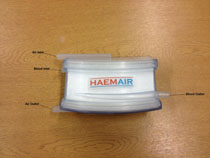Please note, this page has been archived and is no longer being updated.
The technology to create an artificial lung pioneered at Swansea University is to be featured in tonight’s Channel Four science documentary, C4’s How To Build A Bionic Man, which shows how science is increasingly able to replace body parts with man-made alternatives. (Channel 4, Thursday, February 7, 9pm).

Development of the technology was supported by initial research into the flow of complex fluids and flows for engineering applications, carried out by scientist Professor Rhodri Williams at Swansea’s College of Engineering, which was funded by the Engineering and Physical Sciences Research Council (EPSRC).
Working with Professor Adrian Evans, from Swansea’s College of Medicine, and who is also an Emergency Medicine Consultant at Morriston Hospital’s A&E Department, Professor Williams found that his work on fluid flow (rheology) could be applied to blood and had potential uses in medical settings.
This led to the development of sensors for detecting abnormal blood clotting, in partnership with Abertawe Bro Morgannwg University Health Board (ABMU Health Board). Establishing a better understanding of blood rheology, in particular the problems arising from clotting, has contributed to the development of this artificial lung.
Further partnerships between Professor Williams, Professor Evans, the National Institute for Social Care and Health (NISCHR), together with Swansea University’s Institute of Life Science -based company, Haemair, are developing the patented device, with a number of prototypes being developed. Haemair moved to Swansea to benefit from the expertise built up by Professors Williams and Evans. The project has also benefited from facilities at the joint ABMU Health Board/EPSRC laboratory at the Morriston Hospital in Swansea.
The device resembles a small box with inlet and outlet pipes for blood flow. It is intended to be worn externally to assist breathing for patients with chronic illnesses including chronic obstructive pulmonary disease, emphysema and cystic fibrosis.
It is also being developed for use to assist recovery of patients following cardiopulmonary surgery and used to keep patients healthier whilst they are waiting for a lung transplant. Helping patients with breathing will enable more transplants to take place, with better matching and improved survival rates.
In the long term it is intended to be developed as an alternative to lung transplant. Many patients currently die whilst waiting for a donor organ. Currently only one per cent of patients who need a lung transplant receive one because of the shortage of donor organs.
Professor Rhodri Williams said: “Further development of this device has the potential to help patients in desperate need. Most current, established approaches require patients to be largely immobile, treated in intensive care and breathe oxygen. Future versions of this device could enable patients to be treated at home, breathe air and possibly control the device themselves.”
Professor Bill Johns, Director of Haemair said: “It is vitally important that the EPSRC remains able to support the underlying science developed by researchers like Professor Williams - you never know what vital practical application it may have.”
Adrian Evans is Professor of Emergency Medicine and Haemostasis (blood clotting and other ways the body stops excess bleeding). Professor Evans’s work has involved looking at ways to control blood from clotting once it leaves the body – a key part of ensuring the artificial lung works effectively.
The ‘Bionic Man’, built by UK roboticists from Shadow Robot with the support of The Wellcome Trust, will be on show at London’s Science Museum from Thursday, February 7 until Monday, March 11, 2013.
- Thursday 7 February 2013 13.57 GMT
- Thursday 7 February 2013 11.37 GMT
- Swansea University, Tel: 01792 513454
